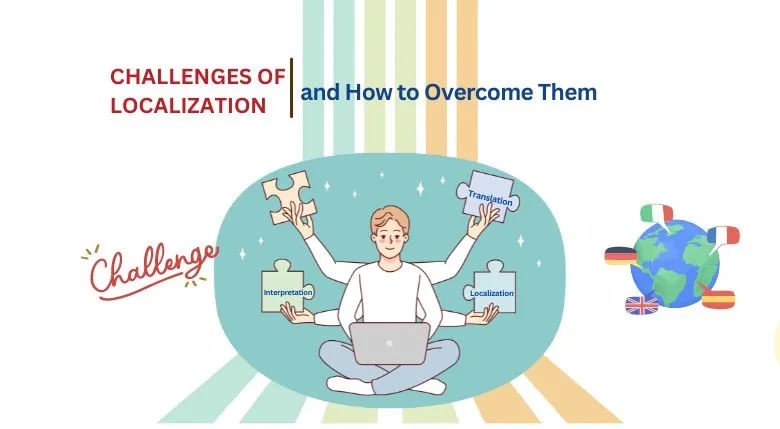
Localization and translation simultaneously, is a particularly demanding process for any business that wants to enter and thrive in the global marketplace. Localization process involves adapting a product or it’s content to meet the linguistic, cultural as well as regulatory requirements of a specific region or customer group. Unlike simple translation the localization strategies for global e-business focus on converting the text from one language to another and ensuring that the generated outcome resonates with the target demographic, providing a smooth and culturally relevant user experience.
However, the path to effective localization is laced with challenges even for the best language translation services. In this blog, we will explore some of these challenges and learn about effective strategies to overcome them, thereby enabling growing businesses to successfully course through the complexities of the global markets.
1. Decoding the Cultural Complexities
Cultural disparities can majorly impact, one’s content is received for a particular audience as what may work in one culture might not work in another.
Case Study: A global food chain faced backlash when in its ad campaign, it featured a thumbs-up gesture when advertising in certain parts of Middle Eastern countries. Even though the thumbs up gesture indicates a positive message in the Middle Eastern countries it is considered to be offensive because it is considered a rude sign, indicating a negative connotation.
Solution:
- Research and Adaptation: Conducting thorough research on the target culture as well as engaging with the local experts who understand the relevant cultural sensitivities can help decode such complexities.
- Seeking Local Review: Seeking local review by native speakers can help in ensuring that the content is ready to be exposed to the target audience.
If you want to explore more about cultural complexities and the role of language in cultural preservation you can read this interesting web blog on Translating Traditions: Role of Language in Cultural Preservation, Challenges and Way Forward.
2. Managing Multiple Languages and Dialects
Languages can have multiple dialects and can vary from region to region, this often complicates the localizing of the text. For instance, Spanish spoken in Spain varies from the Spanish that is spoken in Mexico in terms of vocabulary, expressions, and even grammar.
In order to resolve this challenge:
- Target Centric Dialects: The best way to resolve this issue is to identify the primary dialects of the target demographic and then localize the content accordingly.
- Professional Translators: Hiring professional translators who offer expert human translation and native speakers of the specific dialect can help overcome the issue of efficiently managing multiple languages and dialects.
Do you know overcoming localization challenges can take your business to the next level?
Contact Somya Translators today for customized localization services by th experts.
3. Modifying as per the Local Standards
Countries vary with one another in their regulations and standards which must be adhered to by the approaching business, whether it is in terms of data protection laws or, product labeling requirements.
Solution:
- Staying Informed: Staying informed and updated about the local laws and regulations is important for businesses. Whether they are trying to enter new markets or established in a particular market, keeping an eye on the ongoing trends is an important part of the localization process.
- Legal Consultation: Working with professional legal experts can be beneficial in ensuring that the translations comply with the local standards.
If you want to learn more about the role of legal translation services for growing businesses you can read this engaging web blog on Alleviating Legal Hurdles Role of Legal Translation Services.
4. Handling Technical Difficulties
Technical challenges can arise like text expansion, when converting into languages that utilize more characters, or formatting problems due to different writing systems. This may lead to inconsistencies in the brand’s image across different languages. For instance, when translating a text from English to German the resultant conversion shows expansion in the text which potentially disrupts the layout of the user interfaces.
In order to overcome this challenge:
- Flexibility: To overcome this issue a flexible design must be opted that allows for text expansion and contraction without hampering the layout of the interface.
- Testing: Conduct rigorous testing by humans after the machine translations.
5. Time and Budget Constraints
The process of localization can be costly as well as a tedious and time-consuming affair; especially when dealing with multiple languages in multiple markets.
Solution:
- Prioritizing: Focusing on the priority languages that offer the greatest potential for return on investment can streamline this process.
- Phased Approach: Choosing a phased approach as a part of the localizing strategy, where one starts with the most critical elements and expands to the easiest one can help finish the project within the time and reduce the cost of localization.
Do you know overcoming localization challenges can take your business to the next level?
Contact Somya Translators today for customized localization services by th experts.
6. Ensuring Quality Control
Maintaining decency and uniformity in quality across all localized versions of the product can be a complex task; especially when large volumes of content are being handled which may result in confusions.
To resolve this difficulty:
- Quality Assurance: Implementing robust quality assurance measures which include multiple rounds of review and testing.
- Feedback: Establishing a feedback loop with the users to gain insights about the difficulties that the users are facing will help businesses address the issues promptly.
You should also read this blog Why Do You Need Localization? [5 Key Reasons It Does Matter]
Corollary Words
Localization is a multifaceted process that requires a deep understanding of cultural preferences and local regulations. By implementing the above strategies proactively businesses can easily overcome the localization challenges they face and ensure that their product and content reasonably resonates with their target audience, helps them access new markets, and fosters strong global connections. You may get in touch with Somya Translators, offers one of the best language translation services and avail a free quote!







